When it comes to building links, literally anything and everything that makes a tiny bit of sense will be senselessly amplified by most (inexperienced) SEO practitioners and link building ‘experts’. Let me be candid – it’s frustrating to see this because it diminishes the credibility of the entire digital marketing industry.
One such strategy is visual link building.
In the simplest terms, visual link building (or image-based link acquisition) is all about creating visual assets that other websites would naturally want to link back to. Simple concept, more complex implementation process.
Is it an outdated link building strategy in 2024?
Not at all – but your current approach might need updating.
Is it worth the investment?
Absolutely! However – only if you’re executing it strategically.
What about the overall link building ROI?
While it may not outperform other robust methods like broken link building or scaled content marketing (which is becoming increasingly saturated), visual link building can secure some of the highest quality, most authoritative, and most valuable backlinks. These are the links that truly MOVE the needle. The links that IMPACT rankings!
Now that we’ve addressed these initial questions, let’s dive into the details of visual link building in 2024.
Contents
What Is Visual Link Building? (Image-Based Link Acquisition)
Visual link building centers around creating compelling visual assets – images, videos, infographics, interactive maps, data visualizations, and more – that serve as effective link magnets. The process follows a strategic framework:
- Create high-value visual assets (focus on both creation and distribution).
- Integrate them into your link building strategy.
- Identify relevant opportunities.
- Qualify potential prospects.
- Execute targeted outreach.
- Navigate negotiations when necessary.
- Scale and optimize.
Building Links Via Images – A Quick Case Study
Understanding that images (and other visual content) can generate backlinks is one thing. But to really get to the bottom of things, we need to add a numerical, data-driven perspective.
While creating our step by step link building guide, I referred to the Coke infographic. Without a doubt, it’s a winner. For now, I want to bring things down a notch and discuss something that most of us can easily relate to ( because setting up our baseline at a worldwide-viral piece of content isn’t really relatable ).
Here’s the page I’m talking about. It’s an authority domain, but probably not an industry leader. The page is minimalistic with little to no text content. The infographic itself is pretty neat, simple and full of useful bits of information. That’s all well and fine. But here’s the interesting part:
The page has URL rating of 35 – which is fairly decent. More importantly, it has over 200 backlinks.

Even more important is the quality of these backlinks. A quick look reveals that 90+% of these backlinks are dofollow links and from authority domains – a testament to the quality of the infographic and the value it has created.


Visual link building should always prefer building links at high velocity. That’s the essence of basically going viral. But let’s be realistic: the bigger chunk of links for a quality visual asset will come over a longer timescale – slowly but surely. The point is, the link building ROI of visual link building consistently goes up even when your campaign ends. Therein lies the detail many agencies miss.
Our post on how to calculate link building ROIs talks about this aspect at length.
What Makes Image Link Building Tick? (And The Problem Of Complacency)
I understand that building absolutely top-notch, mind-blowing, ridiculously impressive graphics isn’t easy.
And here’s the thing – it also means you (and your link building team) MUST bring on board a graphics person (or a team). At this precise moment, things slip out of the hands for an SEO – because most of them hate the kind of branching out this creates. It’s never easy to find reliable freelance designers, and the whole once bitten, twice shy attitude kicks in.
What this means is that most visual link building efforts are carried out as an afterthought ( the “Meh, let’s check this off our list” syndrome ), and that means poor output. Needless to say, poor images are never worth sharing, let alone linking back to. So, such visual link building campaigns die a slow, painful death and, worse yet, hurt the overall link building ROI.
So, what’s the solution? What is it that makes visual link building tick?
It’s simple. You need to understand only one thing – a well-done graphic is infinitely more interesting at a mass level than even an extremely informative piece of text.
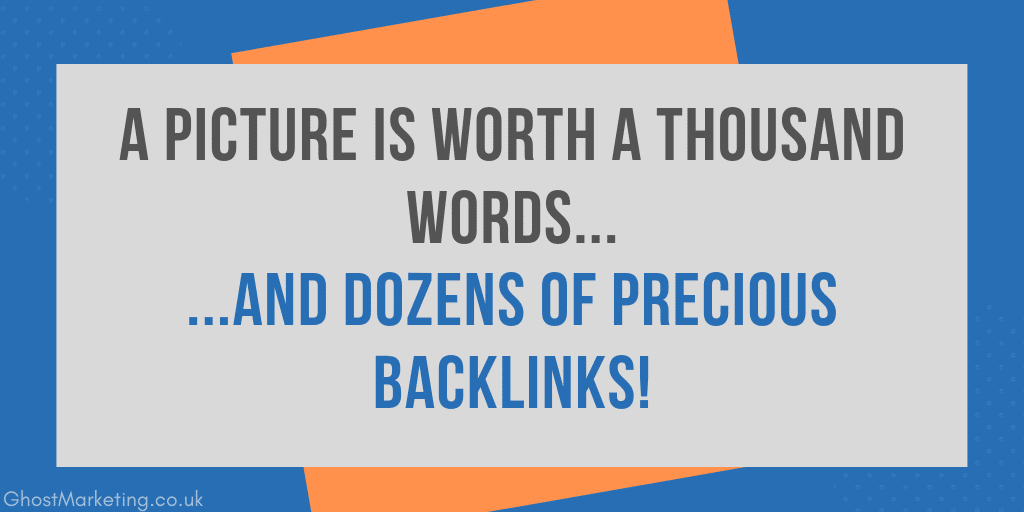
I’m not really a big fan of clichés, but the old ‘A Picture Is Worth A Thousand Words’ needs to be taken seriously in the visual link building context. I’ll even go so far as to say ‘A Picture Is Worth A Thousand Words And Dozens Of Good Links’. It really is!
Link building has as much to do about creativity as it has about expertise and experience. Working with an industry leading link building agency like Ghost Marketing gives you the benefit of both. Get in touch with us to know more about how our link building services can help your business website build thousands of high quality links at high ROIs.
Benefits Of Visual Link Building (Images Link Building Benefits)
If you’re still sitting on the fence regarding image link building, I really don’t blame you.
Having been running a fast-growing link building agency for quite some time now, I’ll only tell you that image link building rarely is the primary link building tactic. At the same time, it’s a really effective complementary tactic that has a phenomenal, long-lasting and exponential impact on the final link building ROI.
Here are some key benefits of visual link building:
1. Visual Content Is An Eyeball Magnet
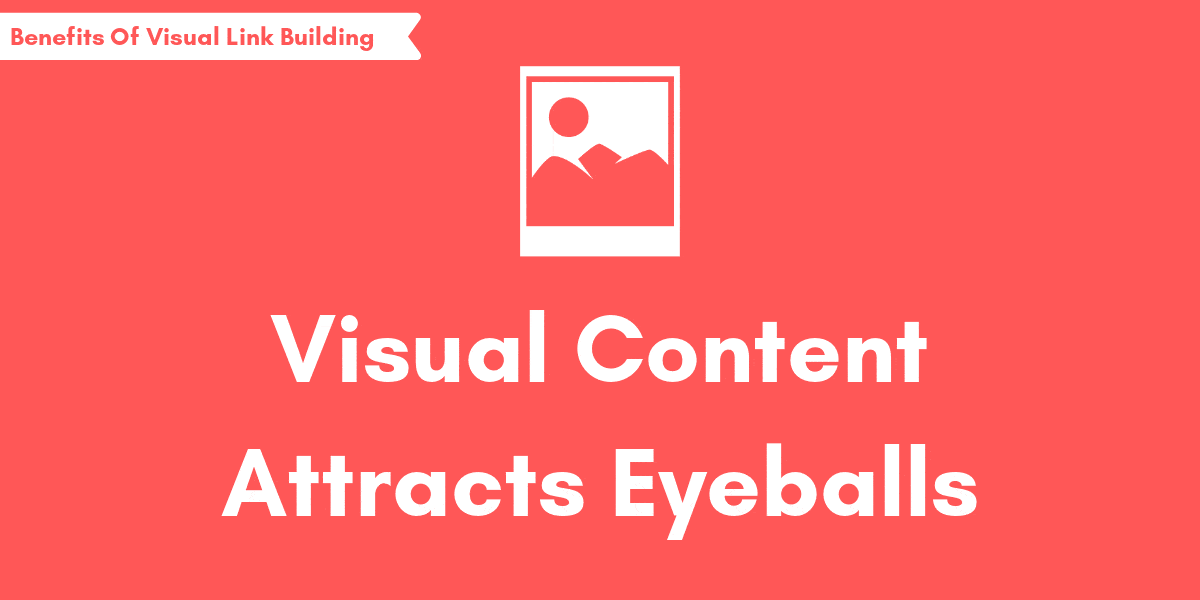
The cliché I talked about just now isn’t just lip service – it’s extremely well-supported by facts and stats. All SEOs and digital marketing agencies rely heavily on trends, and if the trends were anything to go by, it should be pretty obvious that visual link building is indeed effective when executed properly.
Some key metrics that tell us to how well the users are engaged to the on-page content are bounce rate and social shares. Visual content fares better than your average, verbose text walls on both these fronts.
A recent HubSpot survey tells us some very interesting points:
- People remember visual content longer.
- When a page has both text and visual content, people are naturally more inclined to paying more attention to the visual content.
- Pages with visual content are shared almost twice as much when compared to those without.
(Here’s that survey if you want to read up on more numbers)
You must be thinking – how does this help link building?!
It’s not rocket science, really. Consider two scenarios:
- You have visual assets that you want to build links to. Your potential link hosts are aware that if they link to something that receives great engagement, that automatically spells a great deal for them (value creation).
- You want to share visual assets with your potential link hosts. You can just approach them (as a part of your outreach strategy) and let them know that they can share a relevant graphic on their website with a backlink. If the asset is valuable and you play your cards right, trust me, you’ll get good success rate on your pitches (value exchange).
2. Visual Content Is Easier To Pitch.
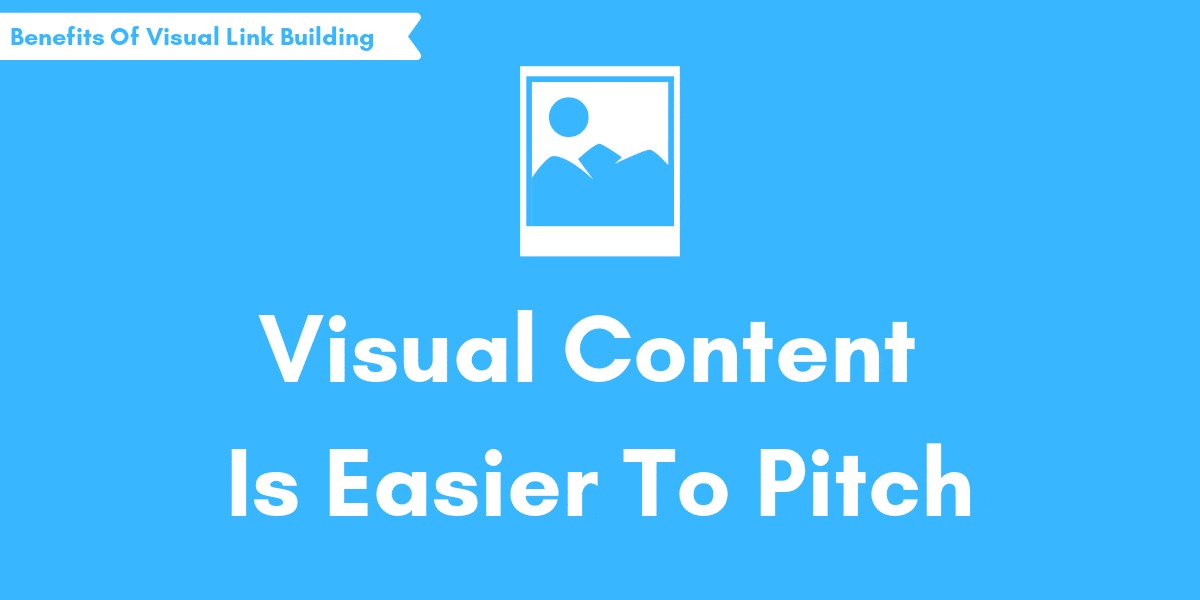
What does your outreach procedure look like? Here’s my guess:
- Shortlist prospects.
- Personalise emails and explain why you deserve a link back.
- Send them out in bulk and hope for the best.
I don’t want to spoil the fun for you, but this generic process is inherently flawed ( at Ghost Marketing, we’ve moved on from this long ago, and we now prioritise personalisation more than anything ). There’s also a very annoying bottleneck: barring the really passionate industry experts, you’re not going to have too many people taking the trouble of going through your website, your blogs, your general content pieces and your thought process before they can decide.
On the other hand, if all you’ve got is an impressive graphic on the table, people will be happy to give it a go because they can – with nothing more than a quick look – see what they are dealing with. They can see the value, they can see the benefits and they can see how it will benefit them. Better response rates, better success rates and higher ROIs.
As a link builder, that is everything I want.
3. Visual Content Can Be Scalable!
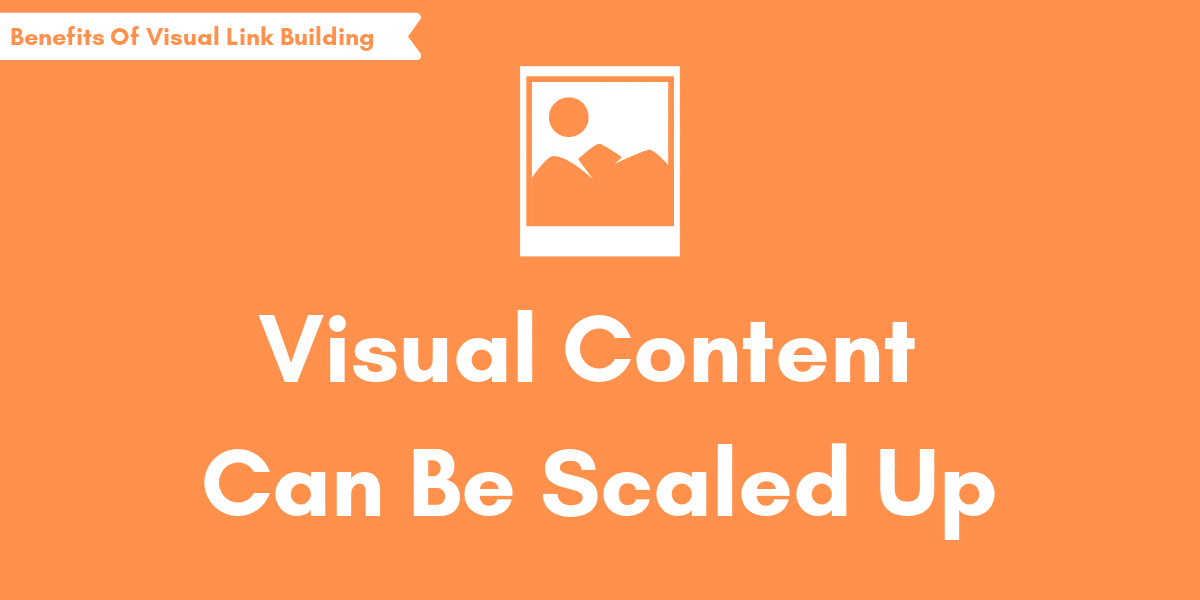
A successful link building campaign is the one that gets you link faster, easier and cheaper. What this also means is that if your link building campaign is scalable, it hands you a massive advantage.
I earlier mentioned that creating good visual content is next to impossible if you don’t have on board a dedicated expert (or a team of experts). However, if you figure that part out, you’ll soon realise that visual assets can be scaled up easily – in fact, much more easily than other content pieces.
This applies more prominently for a certain class of clients.
Businesses that operate in certain industries that have a significant ‘visual’ angle benefit a lot from visual link building. At Ghost Marketing, we regularly handle clients in the lifestyle and services industries. Travel, food, home services, professional services and even B2Bs – they all are ideal candidates for visual content amplification AND the link building opportunities that generates. To see the kind of results you can expect from our link building services, do go through these case studies.
4. Don’t Underestimate The Long Term Benefits.
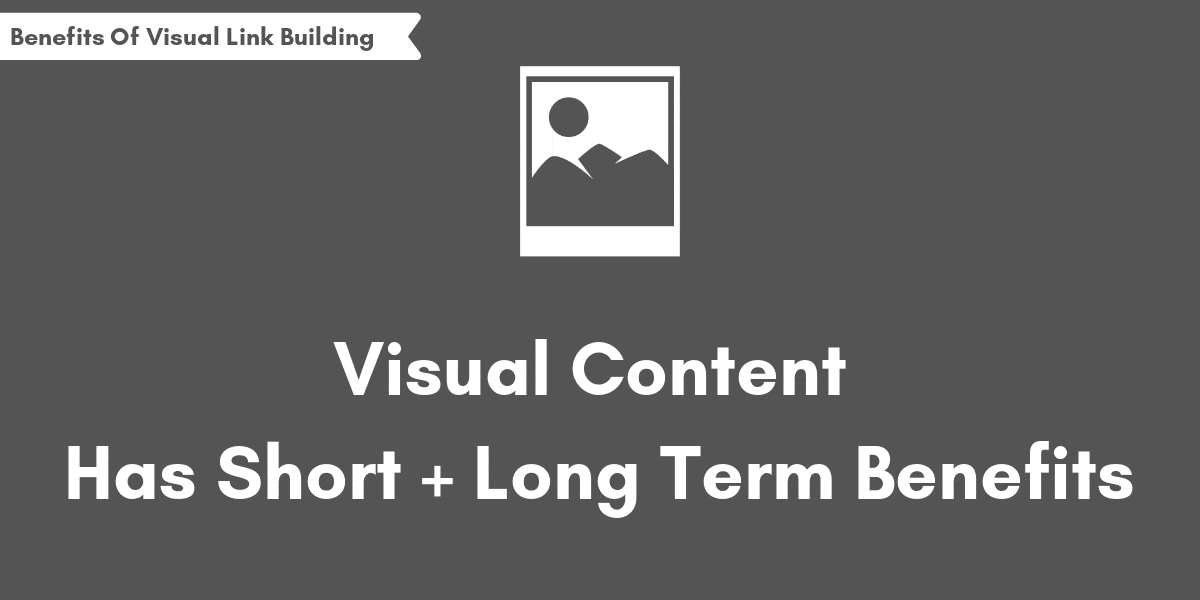
Visual link building usually aims at generating a high volume of links over a short time period. Most agencies – including ours – can only demonstrate the results over a short time (and get paid for those). But, when you’re pitching to a client (or just learning the ropes), you must be aware of the long term benefits of visual link building.
The visual assets that typically go viral represent trendy topics. They will, eventually, stop attracting links because the content becomes stale and nobody wants it anymore. I’m not saying these aren’t important – they are. It’s just that I want to also bring to the light the other side of the coin: evergreen visual assets that keep raking links in months and years after.
Here’s a quick search I ran for “global warming in images”. I filtered the results based on the date of publication and this one caught my eye:

So, it’s safe to assume that over the past 6 years, this page (which is largely based on an infographic) has acquired close to 2k links – a perfect example of long-term benefits of visual link building.
Before We Go Any Further: Some Basic Criteria For Your Images
Image link building is not too different from other link building tactics – all you need to be aware of is the value you’re exchanging. If there’s value, there are links waiting for you. So, before we go ahead with various image link building strategies, let’s define – as simply as we can – this value. In other words, the basic criteria of quality for your visual assets.
As is the case with every other link building strategy, visual link building requires you to bring the best out of multiple fronts: designing, prospecting, outreaching, just to name a few. At Ghost Marketing, we have helped numerous businesses across dozens of industries build thousands of high-quality links that eventually result into higher organic traffic and huge ROIs. You can go through our digital PR and link building process to learn more, and get in touch with us to request a free, customised proposal.
1. You Saw It Here First! 🏅
This is an absolutely precious quality to have – anything that gives you any sort of first-mover advantage has the potential to generate links.
If you can drum up an exciting visual asset that is unique in either the way it’s created or presented, it’s going to be a great addition to your campaigns.
2. I Felt That! 😲
This one runs across the board as far as link building is concerned, probably a touch more so for visual link building. If your visual assets can evoke emotions – surprise, shock, astonishment or curiosity, just to name a few – they are prime candidates for link building.
3. I Totally Relate To This! ✋
If I look at an image and I can instantly relate to what it’s saying, there’s obviously a very high chance that I would want others to know about it (that’s how social media works). In other words, I would be happy to place it on my website and link the piece back to your page – easy as you like.
4. That’s Hot! 🔥
Hot stuff sells. Hot stuff gets clicked on. A major part of your visual link building campaign should always target the hot trends. These will generate higher link volume at higher velocity.
We recently worked with a national marketing agency. As a rule of thumb, we kept producing visual assets that discussed the ongoing industry trends, and needless to say we got a hell of a lot of engagement, links and social media traction . That moved the SEO needle so far in the right direction that their other pages have now been consistently gaining editorial links without any active outreach. Talk about ROIs!
5. This Stuff Never Gets Old! 🌱
Hot stuff will get you links, no doubt. But eventually, hot turns cold and that’s when you want to bank on evergreen assets.
If you can complement your trending visual assets with slow, steady and evergreen graphics (the ones that will be just as relevant, let’s say, in 5 years), that’s a perfect recipe. Evergreen visual assets will keep adding to the ROI and from what I’ve experienced so far, such assets generate high quality links (high DA, high relevancy and high referral traffic).
Image Link Building – Tried And Tested Visual Link Building Tactics For 2019 And Beyond
Now that we have covered almost every base as to the whys, let’s get around to actually discussing how to build links using visual assets.
Like other link building strategies, image link building is all about combining creativity with a bit of marketing. We will save the outreach part for another discussion (to be fair, it’s not too different from other link building methods).
1. Infographics For Link Building
I’d say yes – as long as you know how to work the angles.
You’ll find many SEOs out there bashing infographics as an outdated tactic (rightly so, in some cases), but I still consider them a valuable asset. The caveat here is that your infographic HAS to be 2019-ready. You cannot just create a long winding, scroll-y piece of endless data points and expect people to pay attention. That just doesn’t cut it anymore.
How To Make Infographic Link Building Work?
Obviously, there’s no set play here. Creativity is the real deal maker. You can follow these points to keep your infographics on track:
- Hire specialists to build your infographics. You can hire individual designers or an agency depending on your budget, but make an effort to produce top quality stuff. Remember – the graveyard of poorly made infographics is wide and deep, you don’t want to add to that.
- Know your plan of action. There are two broad types of infographics out there – data visualisation based infographics and guide/explainer infographics. Try and figure out which format works best for your industry.
- If you can come up with new ideas, there’s nothing better than that. Even when you can’t, it’s pretty easy to find inspiration online. Make sure that you don’t straight up copy ideas – add your own touch and make those unique, linkable and, most importantly, worth people’s time.
2. Reverse Engineer Images To Build Links
Go this way or that, our final aim is to build links, and that’s all that matters.
There’s absolutely nothing wrong with reverse engineering images to build links (we use reverse engineering as a profitable link building technique for nearly every link building strategy). Here’s how it works:
- Find relevant and authority websites in your industry/niche.
- Browse through their blogs.
- Categorise these blogs/pages loosely into a few groups.
- Now build images (these could be infographics, simple graphics, original photos or even basic GIFs) that would add value to these pages.
- Create relevant (preferably short) posts for each group on your own website and host these images there.
- Reach out to each group and let them know that they can use these images on their pages. If the images you’ve built add value to their content, they will be more than happy to oblige with a link.
It shouldn’t be too difficult to understand why this works. People who produce online content – especially small/medium sized websites – don’t really have the budget to hire a team of talented graphic designers and artists. So, they usually make do with images from other sites (or, at best, some basic illustrations). If you can solve this problem for them and expect nothing but a link in return, it’s a great deal for the both of you.
Example
Reverse engineering visual assets gives you an edge – you don’t have to ‘sell’ your idea to anybody.
You already know (sort of) that they are going to like it, and as long as the quality you bring on board is good enough, you can rest assured that your success rate will be high. This is one of the main reasons why this approach to visual link building is one of my absolute favourites.
Let’s take the example of an Amazon tax consultant business. Their website, let’s assume, is generating a decent amount of organic traffic but it lacks industry connections in terms of backlinks (meaning that not too many backlinks from industry leaders/authority websites in the same niche). One way to solve this problem is by reverse engineering the image link building strategy for each of their major service.
I’m picking here the “VAT registration assistance for Amazon UK sellers” service. Now, it’s extremely easy to find top websites that:
- Talk about this frequently AND
- Aren’t our client’s competitors
A quick Google search tells me this:
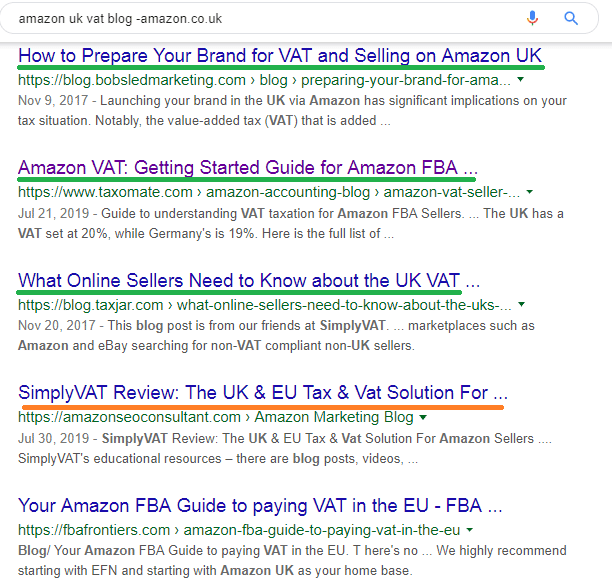
I’ve highlighted the results that interest me (interestingly, there’s one result from the blog of our sister website too, which is great to see). All these pages talk about what VAT is, why Amazon UK sellers need it and how to go about the whole registration process.
I can easily tweak my searches to find more targets in the same area – ideally, I’d like to have a list of at least 50-100 targets that I can reach out to for one specific visual asset. This will guarantee at least a dozen authority backlinks if I play my cards right.
Here’s a sample outreach attempt for this example:

3. Maps For Link Building
As far as I care, any well-made graphic (that is not TOO specific in its nature) is good for link building. Infographics stole the show for many years, but people have moved on and maps, over the last few years, have been quite the rage.
Do not get sucked into believing that one visual form is better than the other. It’s all about creativity and how best you can mould the asset to say what you want to say. Strictly speaking, maps just one-up the old-fashioned infographics, and you really shouldn’t split your hairs while picking one over the other.
More importantly, it should be obvious to any sane person that maps DO NOT fit everyone’s requirements (although you can do some mental gymnastics to find a way).
Here’s a great example of this idea in action:

This map has been featured on countless news reports so far, and is based on a study conducted by McKinsey. The map converts a huge range of data points into a visual representation (which, unfortunately, is rather grim). The map checks all the boxes we talked about earlier – it’s useful, informative, easy to understand, well-produced and worth the time for anyone who is interested in this sort of a thing.
So far so good.
But the real magic lies in the numbers. Let’s fire up some basic backlink analysis to see what this map has going for it.

As can be seen, the page has got close to 500 backlinks. For a report that centres around a visual asset, this is a great number. Digging a little deeper reveals even more information.

The page has acquired backlinks FAST. In as few as 15 days, the number of backlinks shot from 0 to 2,500+, finally settling at around 500 in the following month (the drop is pretty common for link building campaigns – it takes a while before the ‘link equilibrium’ is reached).
What does this tell us?
- The map was really, really good and struck a chord with the people.
- People found it, shared it and other websites quickly jumped on board.
- Since this is an important economic research, chances are more domains will keep linking to it in future. Given its academic AND everyday importance, we can expect some authority editorial links as well.
Interactive Maps For Link Building (Advanced)
Interactive maps – when done right – can not only provide huge value, they also give you a great leverage in terms of link building strategies. You can go a step ahead and allow embedding on other websites for an even better link turnout.
This, however, is an option that’s very limited in nature and should be taken up only if suits your requirements well (and you’re willing to invest a bit of money into building the asset). Of course, if the map format doesn’t work well with your niche, you can always think about building out some other interactive graphics (for example, interactive recipe infographics for restaurants, interactive build-your-own style guides and so on).
Here’s a great example:

As was the case with our earlier example, this map has also been used by dozens of media websites. It makes sense – the Amazon rainforest fires have been a major talking point recently.
Let’s see the backlinks for this page.

A Quick Thought – Using Reddit To Help Your Maps Go Viral
The usual treatment should work fine even for maps – you build a list of targets and digital PR contacts, pitch your idea to them and negotiate if necessary. Once you build a few links this way and the map is good enough, it should have no difficulty getting further traction.
But in the meanwhile, you can aim for some additional boost via social media. I’m referring to one particular option here – Reddit.
Reddit is a wonderful place to float your ideas (I’ve used it MANY times to test out campaigns without spending a dime) – particularly maps, because they align perfectly with the kind of people that regularly use Reddit.
Here’s an example:
See what they did here?
They have literally used the map format to diss the map format – a brilliant strategy, I say. Nothing else matters though, because the post has 27k upvotes and is highly visible to anyone who visits the popular subreddit it’s in.
Now, let’s take a look at the source.

The page has close to 650 high quality backlinks. In addition, the image file URL also has acquired 70 backlinks on its own (many people love to link directly to the image URL).
In short, if you can build a map (or any visual asset for that matter) that you know will get people interested, Reddit is a great place to put it out there for some organic attention.
4. Using Original Photos And Images For Link Building
At this point, we move slightly away from the ‘creative’ process of visual link building and towards a more robust, straightforward approach. Let me be clear – this is a VERY opportunistic way of building links, but there’s absolutely nothing wrong with it and you should give it a go if:
- You’ve got the resources for it,
- It fits the flavour of your industry/niche
So, How Do Original Photos And Images Help Link Building?
It’s easy – if you’ve got the rights to a photo that bloggers, publishers and media websites in your industry desperately want to get their hands on, it’s a free pass to gaining valuable backlinks.
Businesses like Getty Images make a fortune by monetizing original photos – it’s pretty much the same concept. You, on the other hand, are just ‘selling’ the rights to a photo/image for a backlink.
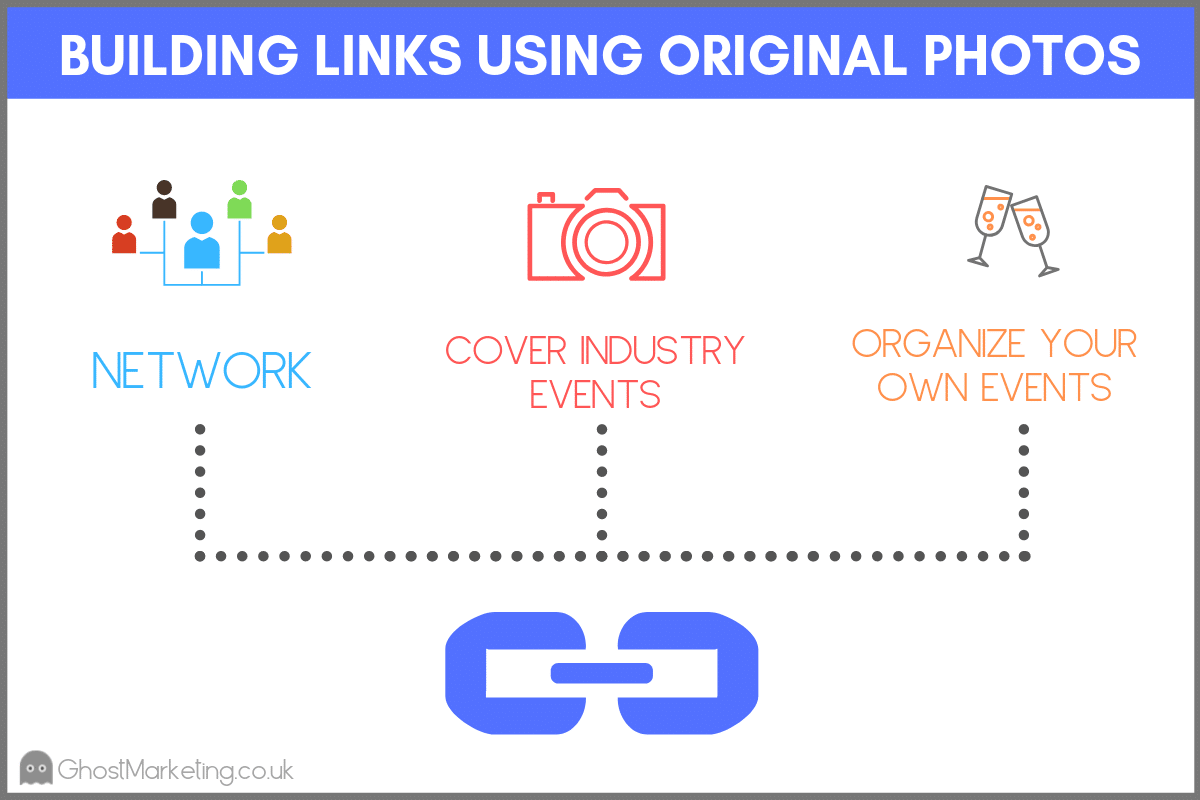
Here’s how:
- Be an active member of your industry. Socialize and build connections (this isn’t just for link building – you’ll benefit immensely in nearly every aspect of your business from this).
- Attend seminars, conferences and other networking events regularly.
- Hire a VERY small team of photographers and offer to cover the event for free. This works incredibly well for smaller events because the organizers love the fact that you’re taking some burden off their shoulders.
- Publish the event photos on your blog and offer them to your peers/organizers/connections.
This Isn’t Everyone’s Idea Of Link Building – But Hang On!
Nothing puts the power of this link building tactic in perspective better than the numbers.
Take any moderately successful photographer business out there and analyse their website – you’re guaranteed to find thousands of backlinks, all from websites that feature their photos. This is similar to web designers whose websites keep pushing the SEO metrics in the right direction using footer links and menu links (although these aren’t the best types of links out there).
Here’s one example to make this point:

5. Reverse Image Search For Missed Link Building Opportunities
This is a tactic that should be reserved for when you have a sufficiently large volume of original images floating out there – infographics, maps, GIFs, photos, illustrations, data visualisations and everything else.
All you have to do is use Google’s reverse image lookup feature and find who’s using YOUR visual assets without linking back to your website. Right Click On The Image (Use Chrome) > Search Google For Image
Then make a list of such targets, add them to a special campaign and reach out to them. Reasonable webmasters will have no problem giving you a link.
But there’s more: don’t just stop here. This will be a perfect opportunity to see if you can work with them in other ways – guest posts, digital PR, link exchange (be careful with this one) and so on. If nothing else is possible right away, build a connection with them that will come handy in near future.
Example
The best part about visual link building is that you may not have to create new visual content to get started – you may already have images that can get you precious backlinks.
Let’s, for example, take this image:

It belongs to one of our sister companies. I had used it as a cover/featured image for an important article, and – needless to say – it was equipped with the right alt text.
I ran a quick reverse image search on this one and found this:

Admittedly, not all of these are going to be authority domains, but the point is clear: a well-produced image will always get you backlinks.
Get It Right And Images Will Bring In Links By The Thousands!
We – at Ghost Marketing – do this day in and day out for our clients. Visual link building may be a more time consuming strategy than, say, broken link building or any of other top link building tactics, but when you get it right, it pays off without fail.
Our team of experienced link building experts has already helped dozens of small, medium and large businesses around the world overcome numerous SEO challenges through white hat, scalable and long-term link building. To know more and to request a free, customised proposal, do feel free to get in touch!

